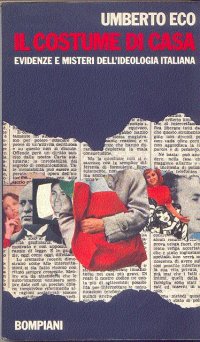Semiotics is the systematic study of sign processes and the communication of meaning. In semiotics, a sign is defined as anything that communicates intentional and unintentional meaning or feelings to the sign's interpreter.

Umberto Eco was an Italian medievalist, philosopher, semiotician, novelist, cultural critic, and political and social commentator. In English, he is best known for his popular 1980 novel The Name of the Rose, a historical mystery combining semiotics in fiction with biblical analysis, medieval studies and literary theory, as well as Foucault's Pendulum, his 1988 novel which touches on similar themes.

Foucault's Pendulum is a novel by Italian writer and philosopher Umberto Eco. It was first published in 1988, with an English translation by William Weaver being published a year later.

Eugenio Montale was an Italian poet, prose writer, editor and translator, recipient of the 1975 Nobel Prize in Literature and one of the finest literary figures of the 20th century.
Hyperreality is a concept in post-structuralism that refers to the process of the evolution of notions of reality, leading to a cultural state of confusion between signs and symbols invented to stand in for reality, and direct perceptions of consensus reality. Hyperreality is seen as a condition in which, because of the compression of perceptions of reality in culture and media, what is generally regarded as real and what is understood as fiction are seamlessly blended together in experiences so that there is no longer any clear distinction between where one ends and the other begins.

Sylvano Bussotti was an Italian composer of contemporary classical music, also a painter, set and costume designer, opera director and manager, writer and academic teacher. His compositions employ graphic notation, which has often created special problems of interpretation. He was known as a composer for the stage. His first opera was La Passion selon Sade, premiered in Palermo in 1965. Later operas and ballets were premiered at the Teatro Comunale di Firenze, Teatro Lirico di Milano, Teatro Regio di Torino and Piccola Scala di Milano, among others. He was artistic director of La Fenice in Venice, the Puccini Festival and the music section of the Venice Biennale. He taught internationally, for a decade at the Fiesole School of Music. He is regarded as a leading composer of Italy's avantgarde, and a Renaissance man with many talents who combined the arts expressively.

Teresa de Lauretis is an Italian author and Distinguished Professor Emerita of the History of Consciousness at the University of California, Santa Cruz. Her areas of interest include semiotics, psychoanalysis, film theory, literary theory, feminism, women's studies, lesbian- and queer studies. She has also written on science fiction. Fluent in English and Italian, she writes in both languages. Additionally, her work has been translated into sixteen other languages.
William Fense Weaver was an English language translator of modern Italian literature.
Guerrilla television is a term coined in 1971 by Michael Shamberg, one of the founders of the Raindance Foundation; the Raindance Foundation has been one of the counter-culture video collectives that in the 1960s and 1970s extended the role of the underground press to new communication technologies.

Pier Vittorio Tondelli was an Italian writer who wrote a small but influential body of work. He was born in Correggio, a small town in the Emilia-Romagna region in Italy and died in nearby Reggio Emilia because of AIDS. Tondelli enjoyed modest success as a writer but often encountered trouble with censors for his use of homosexual themes in his works. Tondelli was buried in a small cemetery in the hamlet of Canolo, just outside Correggio.
Giorgio Prodi was an Italian medical scientist, oncologist and semiotician.
This is a list of works published by Umberto Eco.
Paul Louis Ryan (1943–2013) was an American video artist and communications theorist. His video art encompassed water studies and demonstrations of what Ryan called “a yoga of relationships” or Threeing, culminating in his theoretical development of the Peircean relational circuit and Earthscore notational system.
Fausta Garavini is an Italian writer and translator.
Peter Bondanella (1943–2017) was Distinguished Professor Emeritus of Italian, Comparative Literature, and Film Studies at Indiana University, United States.

Maria Corti was an Italian philologist, literary critic, and novelist. Considered one of the leading literary scholars of post-World War II Italy, she was awarded numerous prizes including the Premio Campiello for the entire body of her work. Her works of fiction were informed by her literary scholarship but also had a distinctly autobiographical vein, particularly her Voci del nord-est (1986) and II canto delle sirene (1989). For most of her career she was based at the University of Pavia where she established the Fondo Manoscritti di Autori Moderni e Contemporanei, an extensive curated archive of material on modern Italian writers.
Enrico Palandri is an Italian academic, writer and translator.
Il Menabò di letteratura was an Italian cultural and literary magazine published between 1959 and 1967. It was based in Turin, Italy.

Il Verri is a quarterly literary magazine, which has been published since 1956. The magazine is based in Milan, Italy.
Mauro Wolf was an Italian sociologist, professor and essayist. He has developed important works in the field of sociology of communication and the media. His books are now considered classical texts in theoretical research on mass communication.








